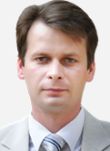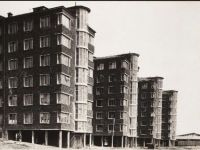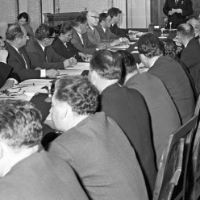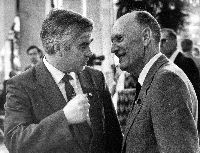THE RESEARCH INSTITUTE OF INSTROSCOPY
core developers

Alexey Efimov
D.Sc. of Engineering Sciences
Deputy Director for Science and Innovation
efimov@niiin.ru
about niin
The Research Institute of Introscopy (NIIIN) was established legitmately on May 6, 1964 with the aim of further developing research and development work on introscopy to meet the needs of the national economy, national defense in instruments and means intravision in opaque bodies and environments.
During this time, employees of the institute developed more than 770 types of devices and installations for non-destructive testing for all sectors of the national economy. Published more than 620 monographs, 3300 scientific articles, more than 5100 copyright certificates and patents for inventions. NIIIN is the author of the National technological platform "Intelligent Diagnostic Systems", the main source of scientific and reference books on non-destructive testing and technical diagnostics.
The employees of NIIIN are laureates of the Prize of the Council of Ministers of the USSR, state prizes of the Russian Federation and prizes of the Government of the Russian Federation.
Currently, NIIIN conducts research and development.It develops, manufactures, supplies NK and TD funds.
The priority area of the institute's development is the development and implementation of digital solutions in the field of non-destructive testing:
- "smart" non destructive inspection ;
- applications using neural network technologies to solve the tasks of evaluating the information content of a conducted NC, the detection and analysis of anomalies of physical quantities recorded in non destructive inspection;
- digital partners of non destructive inspection specialists.
the history of the Research Institute of Introscopy
the formation and organisation of niin
The Research Institute of Introscopy was formed on May 6, 1964, by the decree of the USSR Government.
At the initiative stage of the inventor of radar P.K. Oshchepkov, and after achieving a huge organizational work, he got the permission to cormence the Institute of Introscopy and became its first director.
The idea of combining all the physical methods at a single institute for obtaining multi-element information for intra-vision in opaque bodies turned out not being only timely, but also prompted a more accelerated development and implementation of each of them with the possibility of a complex integration to solve complex industry problems
formation structure
The creation of research subdivisions in all areas of non-destructive testing and technical diagnostics, the solution of personnel issues, the beginning of research work on Government Decisions and business contracts
the beginning of the scientific work and technical council
Active participation of the Institute in the implementation of the most important national economic tasks, preparation for conferences and exhibitions. Organization and holding of the All-Union Conference “Application of Radio Introscopy in Industry”.The Scientific and Technical Council of the Institute has begun work which is a public body that determines the prospects for the scientific and creative activities of scientists. The first collection of tasks of the Institute of Introscopy has been completed
Expo-1967 (Montreal), 5th All-Union Conference on Non-Destructive testing (Sverdlovsk)
The 1967 World's Fair was held in Montreal in honor of the Canadian Confederation centenary from April 28 to October 29. One of the most successful worldwide exhibitions, with more than 50 million visitors and 62 participating countries. It also set a visit record for one day, when 569 thousand visitors came to the exhibition on the third day. From the Scientific Research Institute of Introscopy (Ministry of Instrument Making, Automation and Control Systems of the USSR), an exhibit was presented which is an ultrasound Introscopy based on the universal converter UNIKON-60 (a unique world-class development).
All departments of the Institute took an active part in the preparation and conduct of the 5th All-Union Scientific and Technical Conference on Non-Destructive Testing, which was held in Sverdlovsk. Conference participants visited the Pervouralsk Novotrubny Plant to familiarize themselves with the production of modern pipes and urgent problems for their priority solution.
The non-destructive testing devices developed at the National Research institute of Introscopy were adapted to the conditions of rolling mill 30-102 of the Pervouralsk Novotrubny Plant. The IDT-3 induction flaw detector with a rotating magnetic system and induction overhead converters passed production tests in the conditions of the Pervouralsky Novotrubny plant and then successful interdepartmental tests .
radiointroscopes
Development and testing of hundreds and thousands of radio Introscope elements based on the Unicon-60 universal converter. These multi-element radio Introscopes were developed for the first time in the world.
Identification of research areas
Completion of the Institute reorganization for the development of the main areas of activity such as industrial, medical and special equipment (anti-terrorism and forensic diagnostics)
V.V. Klyuyev become the Director of NRII
Doctor of Technical Sciences, Professor V. Klyuyev, a graduate of Moscow State Technical University named after N.E. Bauman.
Work in all areas has significantly accelerated, numerous interdepartmental and state tests of non-destructive testing means have begun with the aim of their small-scale and mass production for implementation in the national economy
"покорение" вихретока
Development of eddy current transducers and systems as applied to dynamic processes and measurements.
For the first time at a high scientific level, the problem of eliminating the practical influence on the results of monitoring the inertia of eddy current transducers has been solved
понижение дозы облучения пациентов
Development of medical x-ray machines and fluorographs with reduced radiation doses through the use of modern image intensifiers.
Preparation and publication by a team of Soviet and foreign authors of the handbook "X-ray technology" in 2 volumes, edited by V.V. Klyueva
быстродействующие тепловизоры и цифровой толщиномер
Creation of the first IK-10P high-speed thermal imagers based on IR-photoresistance cooled by liquid nitrogen and an optical-mechanical mirror scanning system. Thermography began to develop.
The first ultrasonic thickness gauge with digital indication of measurements UT-30K was developed - a wide-range, portable, high-precision thickness gauge for manual control
создание диссертационного совета
On the basis of the NRII the dissertation council D 520.010.01 in the specialties:
- 05.11.13 "Instruments and methods for monitoring the natural environment, substances, materials and products"
- 05.11.10 "Devices and methods for measuring ionizing radiation and x-ray devices"
RII MSIA "SPECTRUM"
In order to increase the efficiency of research and development, as well as to accelerate the introduction of new developments into production on the basis of Research Institute of Introscopy, the Moscow pilot plant Kontrolpribor and the serial plant Sevkavrentgen, the Moscow scientific and production association Spectrum was formed.
The role of the head organization in it was assigned to the NRIII. The association also included the Special Design Bureau for X-ray Equipment, the Mosrentgen, Kontrolpribor and Zaporizhzhya Flaw Detection Experimental Plants.
Industrial computed Tomography
Organization of a computer room for the purpose of large-scale development of computer technology and its implementation in the progressive development of non-destructive testing. Industrial computed tomography has become one of the main areas of the institute. Extensive work was carried out for the right to hold the 10th World Conference on Tax Code in the USSR
Institute of Electrical Welding E.O. Patona
Visit to the Research Institute of Introscopy and a demonstration exhibition by the director of the Institute of Electrical Welding named after E.O. Paton, Chairman of the scientific council on the problem "New welding processes and welded structures" (under the State Committee of the USSR Council of Ministers for Science and Technology), academician of the USSR Academy of Sciences Paton B.E. in order to familiarize with scientific developments and their implementation in industry
reference book "Devices for non-destructive testing of materials and products"
The publishing house "Engineering" published the first 2nd volume reference book "Devices for non-destructive testing of materials and products", prepared by a team of authors (employees of the Research Institute of Introscopy) under the mentorship of Klyueva V.V. The reference book contains the main results of the research and development work of the Institute in all areas of non-destructive testing over the past 11 years.
abroad expansion
Preparation of documentations, testing and sale of the device SN-30AF (for controlling the homogeneity of rubber mixtures) of the Anglo-American company Monsanto under an optional (license) agreement.
The device made it possible to inspect the quality of rubber mixing ingredients at an early stage in the formation of rubber products (for example, pressure hoses for spacemen to go into space). Production of a batch of devices SN-30AF (140 pcs). At the request of the Ministry of Oil and Gas Industry of the USSR to equip all rubber enterprises.
The beginning of standardization in the field of Non-Destructive Testing ddirectory
A set of tasks has been launched to standardize non-destructive testing methods and tools in all areas, including terms and definitions, methods (general requirements), instruments (general requirements), flaw detectors, thickness gauges, etc.
In the period from 1978 to 1985, more than 50 state standards which govern the requirements for equipments, materials and technologies were developed and put into practice . In the second versions of the reference books “Devices and systems for measuring vibration, noise and shock” was published
Creation of a demonstration center for the development of NIRII
Creation of a full-fledged exhibition center for demonstrating promising developments and solving the most important tasks of the main industries. The beginning of automation and robotization of non-destructive testing.
International Conference on Tax Code in the USSR
Reference "testing equipment"
Preparation, organisation and holding of the 10th International Conference on Non-Destructive Testing at the Moscow Center for International Trade, Scientific and Technical Relations with Foreign CountriesThe event was attended by over 90 countries. At the exhibition from the USSR, more than 100 devices were presented. Edited by Dr. Tech. sciences., prof. V.V. Klyuev in the publishing house "Engineering" published a guide in 2 volumes "Testing equipment"
assistance to higher educational institutions in the creation of specialized departments for Non-Destructive testing
the first in the ussr industrial tomograph vt-300
At MPEI, SZPI, MGUPI, MIREA, with the assistance of NRII, specialized departments were created for the training of engineers on non-destructive testing and Introscopy in the higher education system. Currently, students are taught at 11 universities of the country in the specialty 01/20/02 named "Devices and methods of quality control and diagnostics"Development and large-scale testing of the country's first VT-300 series of industrial computed tomographs. The publishing house "Energoatomizdat" published a book called "Methods and devices for electromagnetic control of industrial products" (V. G. Gerasimov, V. V. Klyuyev, V. E. Shaternikov)
Development of the first in-USSR in-tube flaw detector Development of automatic systems for hot rolled pipes
During 1984, the President of the USSR Academy of Sciences, Academician A.P. Alexandrov. Having convinced himself of the potential of NRII, Academician Aleksandrov personally recommended the institute to solve the tasks of the Union scale, which were successfully implemented in following years.Development and creation of the country's first magnetic flaw detector-projectile for automated in-line diagnostics of oil and gas pipelines (KOD-2 system).The beginning of work on the creation of an automatic non-destructive testing lines for the quality of hot-rolled pipes of mills 30-102 and 140 of the Pervouralsky Novotrubny Zavod (1984-1987). Rolled products with a thickness of up to 12 mm were controlled at a speed of 3 m / s.The composition of the line included induction and flux-probe flaw detectors, a magnetic structuroscope, optical meters for pipe diameter and length, an electromagnetic acoustic thickness gauge, and all the necessary multi-ton means of mechanization and automation of control. Similar control lines were created for the factories of Magnitogorsk, Mariupol, Karaganda and Dnepropetrovsk.
the beginning of work on the "BURAN" project
Beginning of the implementation of a set of tasks to create instruments for ensuring the quality of structural elements and, above all, thermal protection of the Buran space system. The work was carried out until the successful launch of the Buran in 1988.
As part of the Buran program, 123 types of new devices for monitoring and diagnosing defects at all stages of the production of ship components and assemblies were created. Subsequently, many of them found application in the automotive, light, shipbuilding industries, even in public utilities.
Over the years, it has been possible to go through all the stages, from the patented idea of the principle of diagnosis to the commissioning of all devices at the Buran project.
All the main physical methods of non-destructive testing were involved here for instance eddy current, low-frequency acoustic, X-ray television, force-measuring, detachable, optical, capillary, etc.
Republishment of the reference book "Devices for non-destructive testing of materials and products"
Mashinostroenie Publishing House carried out the second edition of the 2-volume reference book “Devices for Non-Destructive Testing of Materials and Products” with additions of the Institute’s developments over the past 10 years
world's first dry point of contact ultrasonic transducers
Development of a series of ultrasonic transducers with a dry point contact for the subsequent creation of ultrasonic flaw detectors (concreteoscopes) for a widespread use in construction.Dry point contact ultrasonic transducers were developed and put into practice for the first time in the world
development of optical pipe inspection systems
development of the upgraded fluorograph FSC-U-01
Development of optical automated systems for in-line inspection of long pipes. Destination systems for identifying the following pipe wall defects:- defects formed during the manufacture of pipes: delamination, sunsets, inclusions, defects of longitudinal welded joints;- defects formed during the construction of the pipeline: risks, seizures, dents, corrugations,- defects in welded joints;- operational defects: external and internal corrosion, fatigue cracks in the pipe body and welded joints due to low-cycle loading.A modernized low-dose fluorograph FSTs-U-01 was developed and put into operation, which allows a mass fluorography of the patient’s chest in a standing position, in a direct, lateral and oblique projections, as well as for performing cranial images and a number of other studies
The creation of the USSR society for non-destructive testing
On the basis of scientific councils of the USSR Academy of Sciences “Automated Testing and Diagnostic Systems” and “Non-Destructive Physical Testing Methods”, the USSR Society for Non-Destructive Testing was created. In September 1989, the Constituent Congress of the OSNK was held, which adopted the Charter and approved the organizational structure of the Company. Corresponding Member of the Academy of Sciences of the USSR, General Director of MSIA “Spectrum” V.V. Klyuev was elected President of OSNK
_
___
The first RONKTD congress
The first congress of the Russian Society for Non-Destructive Testing and Technical Diagnostics was held on December 6, 1991 in Moscow. The governing bodies of the Company were identified at the congress: the Central Board of the RONKTD of 67 people, the Presidium of the Central Board of 27 people
The central government bureau consisted of seven people. RAS V.V. Klyuev was elected chairman of the RONKTD.
RAS V.E. Shcherbinin became his deputies. RAS,
N.P. Aleshin, A.K. Gurvich, V.G. Firstov. N. S. Danilin and V. P. Vavilov were also included in the RONKTD bureau.











































